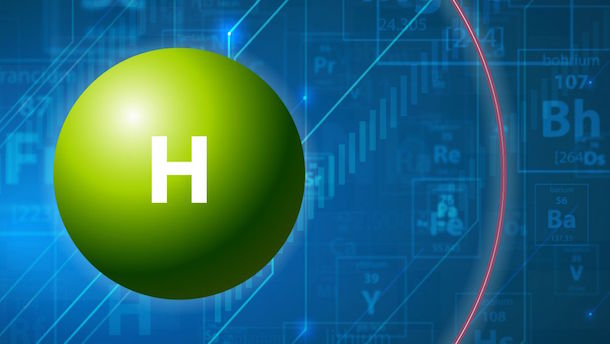Let's start at the beginning. In this case, that means hydrogen. Danish physicist Niels Bohr first proposed its structure in 1913, an achievement for which he would later receive the Nobel Prize. And as the century wore on, the smallest element proved its outsize power. Hydrogen redefined warfare, and the menace it posed loomed over the world throughout the Cold War. Today, it remains a vital input. Though the hydrogen economy that some leaders and scientists heralded a decade or two ago may not come to fruition anytime soon, hydrogen still has the power to change the world.
From War to Travel and Back
In its most abundant form, hydrogen consists of two subatomic particles: a positively charged proton, and a negatively charged electron. The addition of a neutral subatomic particle, or neutron, yields the naturally occurring isotope deuterium. A second neutron produces the last known, artificially created isotope of hydrogen, tritium. Occurring naturally as a pair of atoms, hydrogen gas can be liquefied at very low temperatures and is flammable. In fact, reactions between hydrogen atoms help power the sun. The element's contributions to modern history have been no less impressive.
The Wright brothers pioneered flight at Kitty Hawk, North Carolina, in 1884, but it was the Germans' use of the dirigible in 1915 that marked the dawn of an era of offensive air power. Hydrogen played a vital role in getting the giant floating ships off the ground. The gas is lighter than air, enabling airships such as Count Ferdinand von Zeppelin's first prototype, built in 1900, to escape the confines of gravity with ease. Although the crafts' large size and slow speed eventually relegated them to surveillance platforms once bomber aircraft came along in 1917, their use during the early years of World War I changed how war was waged. The dirigible allowed the Germans to conduct long-range aerial attacks that had a definitive psychological effect on their enemies, despite their comparatively low casualty counts.
Even after they'd reached the limit of their use in combat, the ships continued to serve a niche market shuttling passengers across the Atlantic for a time in the early 20th century. The infamous Hindenburg made more than 60 of these trips before its disastrous final landing — not the first accident of its kind. The number of accidents, along with the gas's inherent flammability, cut short hydrogen's role in dirigible flight. After the 1930s the more expensive, but inert, helium gas became the industry standard. Dirigibles have since gone on to enjoy a renaissance of sorts today for military surveillance and imagery collection. Hydrogen, meanwhile, found a new application in warfare.
Fission for Fusion
In 1934, Ernest Rutherford demonstrated that two deuterium atoms could combine to form helium, releasing large amounts of energy. The process, fusion, is one of the same reactions that fuels the sun. Within a decade of Rutherford's discovery, scientists were discussing ways to harness fusion in a weapon. The idea temporarily took a back seat to fission bombs, which split uranium and plutonium ions to generate powerful blasts. But once rumors that the Soviet Union had also attained nuclear capabilities were confirmed, the hydrogen bomb became the subject of an international frenzy. Many people — including Robert Oppenheimer, who headed the team at Los Alamos that devised the atom bomb — argued against developing the new weapon on moral grounds. They also reasoned that negotiating over the weapon would be easier before any nation had managed to produce it. Still, the United States needed more powerful weapons to ensure its military advantage over the Soviet Union. And so, the thermonuclear or hydrogen bomb was born.
Uncertainty and fear drove the development of a thermonuclear weapon. With limited information on the Soviet program, U.S. physicists and engineers pushed forward under the scientific guidance of Edward Teller. Teller, along with Stanislaw Ulam, eventually realized that the radiation from a fission reaction could provide enough energy to spark the fusion of hydrogen isotopes. The fusion, in turn, results in an explosion far more powerful than the ones that struck Hiroshima and Nagasaki less than a decade earlier. Sure enough, when the United States tested early thermonuclear bombs, including one dubbed "Ivy Mike," on the Enewetak Atoll on November 1, 1952, they produced the world's first megaton explosion. U.S. scientists went on to test different configurations and sources for the deuterium in the years to come, and by 1955, the Soviet Union had achieved its own megaton explosion. Though the two world powers never deployed the hydrogen bombs in their rapidly growing arsenals, their ceaseless one-upmanship underpinned the strategy of mutual deterrence that came to define the Cold War.
Fueling the Future?
In the decades since, hydrogen has continued to serve several functions beyond the scope of war. Demand for the gas is still high, especially in the Asia-Pacific region, for its use in petroleum refining, methanol production and fertilizer manufacturing. Its importance to these processes will keep driving growth in the hydrogen market, which is expected to exceed $152 billion in 2021. By contrast, demand for hydrogen as a fuel is low today, compared with gasoline and even rechargeable batteries. That could change, however, as hydrogen fuel cells gain ground in the coming decades — potentially giving the smallest element a new role in geopolitics.
Fuel cells convert the chemical energy present in hydrogen into electricity. (How the conversion happens is a story for another element.) The technology operates much as a battery does, except that instead of recharging, a cell can run off a continuous supply of hydrogen in a stationary setting or refuel periodically as a traditional gasoline-powered engine does. Fuel cells show so much promise as a power source that for a time, scientists hailed the advent of an economy based around hydrogen. Their optimism has since ebbed, along with government support for the technology in the United States. Nevertheless, fuel cells — whether to power vehicles or to help satisfy demand for electricity — will probably be one of several technologies that usher in the transition from hydrocarbons, however gradual it may be.
Before hydrogen can contribute to this shift, though, the process for its production must change. As it stands, hydrogen gas is inextricably linked to oil production; the vast majority of it is produced during the refining process for either natural gas or oil. Electrolysis, which uses electricity to split water molecules — composed of hydrogen and oxygen — accounts for only a small fraction of hydrogen gas production, because the process is comparatively more expensive and less efficient. Until the method improves, it will keep hydrogen fuel cells from reaching their full potential as an alternative energy source.

The countries that stand to benefit most from the rise of fuel cells are spearheading research and development initiatives to advance the technology. Japan, for instance, has not only the technological prowess and experience to push hydrogen fuel cells forward, but also the geopolitical incentive. Resource scarcity is a recurring theme in Japanese history and a driving concern behind its decision-making. As the country comes to grips with its declining demographics, easing the strain on the Japanese economy by phasing out imported fuels in favor of renewable or domestically generated energy sources is a top priority. Japan's government has set a goal to show off the country's achievements in hydrogen fuel cell development when Tokyo hosts the Summer Olympic Games in 2020. To that end, it is subsidizing the cost of expensive fueling stations for hydrogen cells. Toyota Motor Corp. unveiled one of the world's most advanced fuel cell-powered vehicles, the Mirai, in July 2016, while the Toshiba Corp. opened Japan's largest electrolysis plant. In addition, the company has continued investment in research to improve hydrogen cells. Nearby South Korea, too, has increased its hydrogen production over the past decade.

Still, a global hydrogen economy is highly unlikely. And regardless, no technology will single-handedly cause the transition away from fossil fuels and toward diversified energy sources. With continued research and development, however, fuel cells could help encourage the shift, especially on a regional level. Hydrogen will play an important supporting role in this process, along with elements such as lithium (used in batteries), silicon (in solar panels) and neodymium (in wind turbines). Each of these innovations has already made strides toward breaking the global dependence on hydrocarbons. But they will all face the same fundamental challenge before they can change the geopolitical dynamic: bringing costs down in the face of low oil prices.






